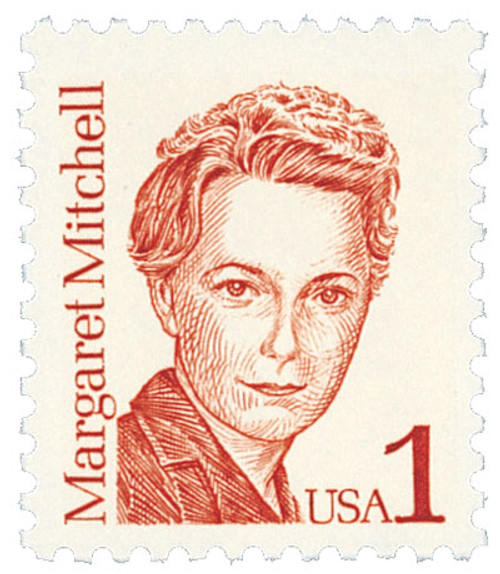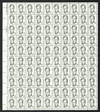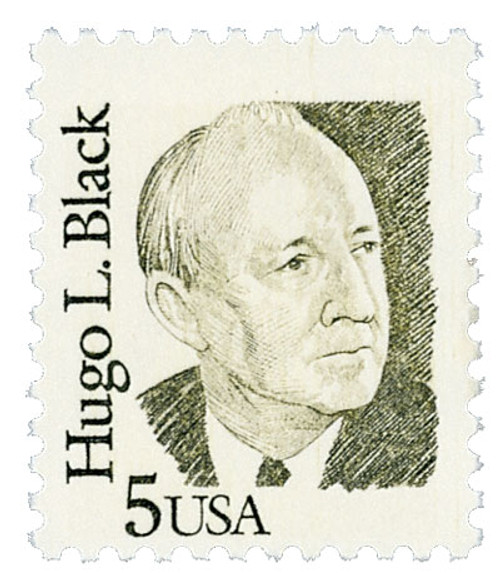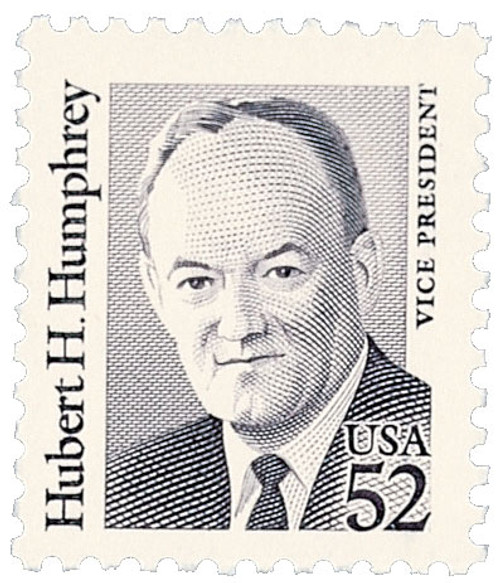
# 1861 - 1983 20c Great Americans: Thomas H. Gallaudet
U.S. #1861
1983 20¢ Thomas H. Gallaudet
Great Americans
- 10th stamp in the Great Americans Series
- 2nd stamp in the series with 20¢ first-class denomination
- Issued at the American School for the Deaf, which Gallaudet founded
Stamp Category: Definitive
Series: Great Americans
Value: 20¢; first-class rate.
First Day of Issue: June 10, 1983
First Day City: West Hartford, Connecticut
Quantity Issued: 300,000,000
Printed by: Bureau of Engraving & Printing
Printing Method: Engraved
Format: Panes of 100
Perforations: 11 x 10.5
Color: Green
Why the stamp was issued: To meet the first-class rate – this was the second stamp in the series with the 20¢ denomination. The stamp design was first unveiled at Gallaudet College in Washington, DC in June 1982. At that time, the stamp had a 3¢ denomination. But during the ceremony, the postmaster general announced that the stamp would bear the first-class rate.
About the stamp design: Dennis Lyall created the art for the Thomas H. Gallaudet stamp. The people who had pushed for the Gallaudet stamp insisted that it include his middle initial or middle name, to avoid confusion with his son, also named Thomas Gallaudet.
First Day City: The First Day ceremony for this stamp was held at the American School for the Deaf in West Hartford, Connecticut, which Gallaudet founded.
Unusual fact about this stamp: Stamps have been found with severe perforation shifts.
About the Great Americans Series: The Great Americans Series was created to replace the Americana Series. The new series would be characterized by a standard definitive size, simple design, and monochromatic colors.
This simple design included a portrait, “USA,” the denomination, the person’s name, and in some cases, their occupation or reason for recognition. The first stamp in the new series was issued on December 27, 1980. It honored Sequoyah and fulfilled the new international postcard rate that would go into effect in January 1981.
The Great Americans Series would honor a wider range of people than the previous Prominent Americans and Liberty Series. While those series mainly honored presidents and politicians, the Great Americans Series featured people from many fields and ethnicities. They were individuals who were leaders in education, the military, literature, the arts, and human and civil rights. Plus, while the previous series only honored a few women, the Great Americans featured 15 women. This was also the first definitive series to honor Native Americans, with five stamps.
The Bureau of Engraving and Printing (BEP) produced most of the stamps, but private firms printed some. Several stamps saw multiple printings. The result was many different varieties, with tagging being the key to understanding them. Though there were also differences in perforations, gum, paper, and ink color.
The final stamp in the series was issued on July 17, 1999, honoring Justin S. Morrill. Spanning 20 years, the Great Americans was the longest-running US definitive series. It was also the largest series of face-different stamps, with a total of 63.
Click here for all the individual stamps and click here for the complete series.
History the stamp represents: Thomas Hopkins Gallaudet was born on December 10, 1787, in Philadelphia, Pennsylvania. From a young age he wanted to be a priest, but also considered other vocations. He graduated from Yale University at 17 before earning his master’s degree there three years later.
After graduating, Gallaudet considered a career in law, trade, or theology. He chose to attend Andover Theological Seminary and became a preacher in 1814. However, Gallaudet changed his plans after he met a young girl named Alice Cogswell. Alice had suffered a terrible fever that left her deaf. At the time, America had no schools that taught deaf children, so her father, Mason Fitch Cogswell, met with Gallaudet.
After spending some time with the girl, Gallaudet believed that, contrary to practices at the time, she could be taught. Cogswell and nine other citizens realized the need for a special school for these children. They raised money and sent Gallaudet to Europe to find qualified teachers.
Gallaudet’s first choice, the Braidwoods, demanded compensation for every student taught using their method. Refusing to pay this fee, he turned to the School for the Deaf in Paris. Soon, Gallaudet was on his way back to America, learning sign language from Laurent Clerc on the boat. On April 15, 1817, Gallaudet and Clerc opened the American School for the Deaf in Hartford, Connecticut. This was the first school for deaf children in America. About two years later, the school became the first of its kind to receive federal aid.
Gallaudet went on to write children’s books and continue to be a champion for the deaf. He died on September 10, 1851, in Hartford, Connecticut. Years later, his youngest son helped to establish Gallaudet University in Washington, DC, in his honor.
U.S. #1861
1983 20¢ Thomas H. Gallaudet
Great Americans
- 10th stamp in the Great Americans Series
- 2nd stamp in the series with 20¢ first-class denomination
- Issued at the American School for the Deaf, which Gallaudet founded
Stamp Category: Definitive
Series: Great Americans
Value: 20¢; first-class rate.
First Day of Issue: June 10, 1983
First Day City: West Hartford, Connecticut
Quantity Issued: 300,000,000
Printed by: Bureau of Engraving & Printing
Printing Method: Engraved
Format: Panes of 100
Perforations: 11 x 10.5
Color: Green
Why the stamp was issued: To meet the first-class rate – this was the second stamp in the series with the 20¢ denomination. The stamp design was first unveiled at Gallaudet College in Washington, DC in June 1982. At that time, the stamp had a 3¢ denomination. But during the ceremony, the postmaster general announced that the stamp would bear the first-class rate.
About the stamp design: Dennis Lyall created the art for the Thomas H. Gallaudet stamp. The people who had pushed for the Gallaudet stamp insisted that it include his middle initial or middle name, to avoid confusion with his son, also named Thomas Gallaudet.
First Day City: The First Day ceremony for this stamp was held at the American School for the Deaf in West Hartford, Connecticut, which Gallaudet founded.
Unusual fact about this stamp: Stamps have been found with severe perforation shifts.
About the Great Americans Series: The Great Americans Series was created to replace the Americana Series. The new series would be characterized by a standard definitive size, simple design, and monochromatic colors.
This simple design included a portrait, “USA,” the denomination, the person’s name, and in some cases, their occupation or reason for recognition. The first stamp in the new series was issued on December 27, 1980. It honored Sequoyah and fulfilled the new international postcard rate that would go into effect in January 1981.
The Great Americans Series would honor a wider range of people than the previous Prominent Americans and Liberty Series. While those series mainly honored presidents and politicians, the Great Americans Series featured people from many fields and ethnicities. They were individuals who were leaders in education, the military, literature, the arts, and human and civil rights. Plus, while the previous series only honored a few women, the Great Americans featured 15 women. This was also the first definitive series to honor Native Americans, with five stamps.
The Bureau of Engraving and Printing (BEP) produced most of the stamps, but private firms printed some. Several stamps saw multiple printings. The result was many different varieties, with tagging being the key to understanding them. Though there were also differences in perforations, gum, paper, and ink color.
The final stamp in the series was issued on July 17, 1999, honoring Justin S. Morrill. Spanning 20 years, the Great Americans was the longest-running US definitive series. It was also the largest series of face-different stamps, with a total of 63.
Click here for all the individual stamps and click here for the complete series.
History the stamp represents: Thomas Hopkins Gallaudet was born on December 10, 1787, in Philadelphia, Pennsylvania. From a young age he wanted to be a priest, but also considered other vocations. He graduated from Yale University at 17 before earning his master’s degree there three years later.
After graduating, Gallaudet considered a career in law, trade, or theology. He chose to attend Andover Theological Seminary and became a preacher in 1814. However, Gallaudet changed his plans after he met a young girl named Alice Cogswell. Alice had suffered a terrible fever that left her deaf. At the time, America had no schools that taught deaf children, so her father, Mason Fitch Cogswell, met with Gallaudet.
After spending some time with the girl, Gallaudet believed that, contrary to practices at the time, she could be taught. Cogswell and nine other citizens realized the need for a special school for these children. They raised money and sent Gallaudet to Europe to find qualified teachers.
Gallaudet’s first choice, the Braidwoods, demanded compensation for every student taught using their method. Refusing to pay this fee, he turned to the School for the Deaf in Paris. Soon, Gallaudet was on his way back to America, learning sign language from Laurent Clerc on the boat. On April 15, 1817, Gallaudet and Clerc opened the American School for the Deaf in Hartford, Connecticut. This was the first school for deaf children in America. About two years later, the school became the first of its kind to receive federal aid.
Gallaudet went on to write children’s books and continue to be a champion for the deaf. He died on September 10, 1851, in Hartford, Connecticut. Years later, his youngest son helped to establish Gallaudet University in Washington, DC, in his honor.




















